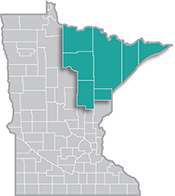 Home to the state's second-largest metro, the Northeast Region has a strong industrial sector, tied largely to the area's abundant natural resources.
Home to the state's second-largest metro, the Northeast Region has a strong industrial sector, tied largely to the area's abundant natural resources.
Most of the manufacturing base centers on mining and forest products industries. More than half of the sector's employment is in paper and machinery manufacturing.
Want the freshest data delivered by email? Subscribe to our regional newsletters.
9/26/2018 12:00:00 PM
Erik White

With 8,500 employees at 344 establishments, manufacturing is the sixth largest employing industry in the seven-county Northeast Minnesota planning region. In fact, Northeast Minnesota has the lowest concentration of manufacturing employment of the six planning regions in the state, with only 5.9 percent of total jobs in manufacturing compared to 11.2 percent concentration statewide.
The manufacturing industry has enjoyed a slight increase in jobs over the past year, but the long-term trend has been a significant decrease of employment. There were 12,237 manufacturing jobs in the Arrowhead region at the start of the century, but employment bottomed out at 8,299 jobs in 2010 at the height of the recession. The industry rebounded with an increase of 670 new jobs from 2010 to 2012, but has struggled to grow since then (Figure 1).
With 1,953 employees, paper manufacturing is the largest manufacturing subsector in the region. However, this subsector has been hit hard with layoffs occurring at various paper plants in the area over the past five years, resulting in a loss of 431 jobs – or over one-fifth of all paper manufacturing employment.
In contrast, machinery manufacturing now has 1,178 employees at 30 firms in Northeast Minnesota after increasing employment by nearly 100 jobs in the last year. The transportation equipment manufacturing subsector has also seen significant employment gains, adding more than 140 jobs in the last year and 381 new jobs in the past five years, expanding its employment by 80 percent in that time frame.

An important aspect of the manufacturing industry is that it provides a bigger paycheck than the average job in the region. According to DEED’s Quarterly Census of Employment and Wages (QCEW) data tool, the average annual wage for a manufacturing job is $58,708 – more than $15,500 higher than the average annual wage across all industries in the region. Within the manufacturing sector, paper manufacturing has the highest wages with an average annual wage of $81,900, which is nearly twice as much as the average wage in the region (Table 1).

Manufacturers have high optimism regarding their current and future prospects. Enterprise Minnesota produces an annual survey that provides insights into the opportunities and challenges the industry faces by interviewing more than 400 manufacturing executives across the state. The results from the 2018 State of Manufacturing report show high levels of confidence in their financial prospects, with many manufacturers expected to expand.
Among all manufacturers statewide, 65 percent say they expect to see economic expansion. Although that percentage is lower in Northeast Minnesota – where 55 percent shared the rosy outlook for the year. Meanwhile, 93 percent of respondents were confident about the future of their company, similar to the 94 percent recorded in 2017 and considerably higher than the 79 percent reported in 2008.
The survey also documented challenges. Topping the list is the cost of providing employee-related health care, an issue that has been the most identified concern each of the 10 years the report has been compiled. After the costs of health care, 47 percent of manufacturers reported attracting qualified workers as a big concern, 40 percent suggested government policies and regulations, and 36 percent stated retaining qualified workers was a challenge.
Attraction and retention of workforce is difficult, especially in a tight labor market, where there are as many or more job openings than there are job seekers. Manufacturers throughout the state will feel the crunch, especially if they are also dealing with employees who are reaching retirement age. Interestingly, only 53 percent of manufacturers surveyed are responding to the worker shortage by using a formal strategic planning process, with greater contrast between high-revenue manufacturers and those with less than $1 million in developing and applying a strategy to deal with the workforce shortage. Enterprise Minnesota can help those manufacturers get a handle on upcoming challenges and is a great resource for the manufacturing industry in Northeast Minnesota and statewide.
Contact Erik White.